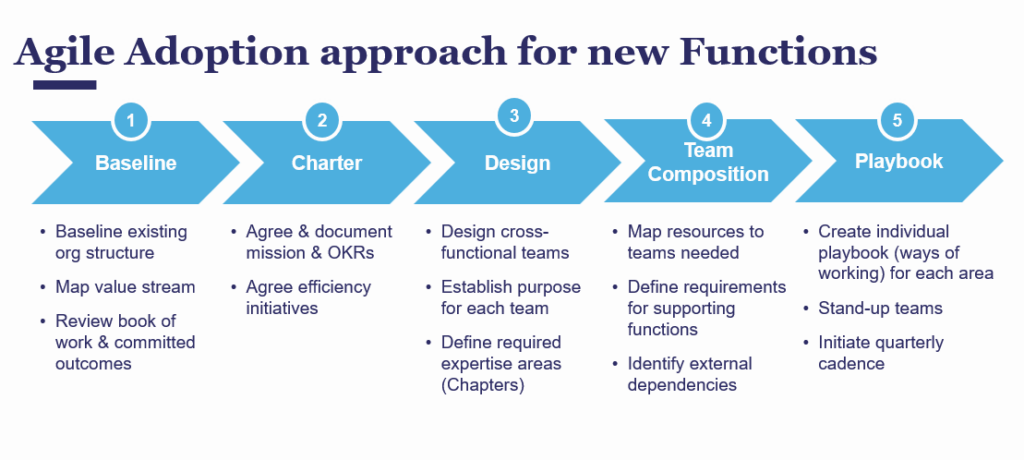Transforming a Global Investment Banking Division
- Financial Services, Business Agility
Our client, a global investment bank, had embarked on a multi-year transformation and remediation journey to improve their cyber security capabilities. However, they needed to accelerate delivery, improve the quality of their technology solutions and ensure better adoption by the business function. Furthermore, a recent audit finding necessitated the enhancement of their project management and governance standards. Below we look at some of the challenges and how MP led an agile transformation program that helped optimise the operating model and improved the banks ways of working.
Accelerating delivery and reducing dependencies
The bank’s hierarchical matrix delivery model was becoming increasingly less effective. It was slow to respond to change, teams were operating in silos and some solutions were delivered by multiple external vendors and contractors, leading to complex dependencies that were difficult to manage. The organisation faced other challenges, including a shortage of skills in certain teams and an inability to redeploy talent to high-priority initiatives.
The work was being delivered using a traditional/waterfall approach and governed by centralised performance and reporting requirements. Lacking a consistent approach to workflow management, much of the governance and reporting were done manually, imposing a significant administrative burden.
Coaching and Agile ways of working
Designing an effective operating model is crucial to an organisation’s success. Optimisations can significantly improve their ability to deliver top-priority solutions to customers in the shortest possible time frame.
Working closely with the management group, MP took a structured and proven approach to designing an operating model that was fit for purpose and addressed some of the department’s most pressing challenges. The figure below outlines our approach.

During the Understand and Identify phases, we validated the departmental strategy and alignment needs, mapped out the as-is state, and workshopped the environmental and organisational factors that would either inhibit or enable change. In the Design phase, we explored a variety of operating model options.

By organising the client organisation around product capability (Option 1), we were able to reduce inter-team dependencies and establish a greater focus on prioritisation at the product/solution level. The operating model design and subsequent value stream mapping activity informed the program structure, the number / type of agile roles needed, and the transition plan.
To guarantee a seamless transition, we established a well-defined vision for the target end state, created a transition roadmap and a comprehensive change management plan. With strong top-down support, we followed an agile adoption approach, beginning with one pilot delivery unit, before expanding the transition to others. By implementing this approach, we ensured a smooth and effective adoption of the new operating model, minimising disruption and maximising success.

During the transformation, the M|P coaches successfully introduced and integrated a range of crucial agile concepts and practices, including:
- Implementation of agile governance and core working ceremonies, such as timeboxing work around sprint and increment cycles, and conducting collaborative planning during Big Room Planning and Sprint planning sessions.
- Instilling a mindset of ruthless prioritisation by implementing effective product backlog management and coaching the product managers to ensure that resources were allocated to high-priority initiatives.
- Enhancing tooling and metrics by introducing standardised fields in JIRA, configuring Scrum Boards in JIRA to teams, and automating metrics and data dashboards to provide real-time insights and visibility.
- Cultivating a culture of continuous improvement by establishing a regular cadence of inspect and adapt sessions, as well as retrospecting on core processes and ways of working, to drive continuous improvement and maximise value delivery.
Benefits of using a Coaching Approach and Agile
Through the implementation of the target operating model and the embedding of key agile ways of working, the MP consulting team delivered a number of tangible benefits that positively impacted the client’s operations. These included:
- Improved time-to-market for solution development, enabling the organisation to deliver higher-quality solutions in shorter timeframes
- Increased transparency of the delivery model and improved visibility of overall work, providing greater insight into the progress of initiatives and enabling more effective decision-making
- Creation of a leaner, more efficient organisational structure that facilitated greater collaboration and communication among teams, leading to increased productivity and improved performance
- Better management of dependencies, reducing the risk of delays and allowing for more effective coordination of work across teams
Overall, these benefits contributed to a more agile, responsive, and effective organisation that was better equipped to meet the needs of its customers.
Interested in our Business Agility services?
This article was written by David Arrick, Technical Director.
Loved what you just read?
Let's stay in touch.
No spam, only great things to read in our newsletter.


